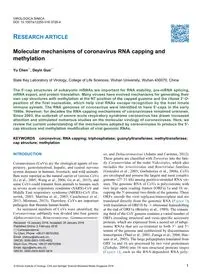
2016 Molecular mechanisms of coronavirus RNA capping and methylation PDF
Preview 2016 Molecular mechanisms of coronavirus RNA capping and methylation
VIROLOGICA SINICA DOI: 10.1007/s12250-016-3726-4 RESEARCH ARTICLE Molecular mechanisms of coronavirus RNA capping and methylation Yu Chen *, Deyin Guo * State Key Laboratory of Virology, College of Life Sciences, Wuhan University, Wuhan 430070, China The 5′-cap structures of eukaryotic mRNAs are important for RNA stability, pre-mRNA splicing, mRNA export, and protein translation. Many viruses have evolved mechanisms for generating their own cap structures with methylation at the N7 position of the capped guanine and the ribose 2′-O- position of the first nucleotide, which help viral RNAs escape recognition by the host innate immune system. The RNA genomes of coronavirus were identified to have 5′-caps in the early 1980s. However, for decades the RNA capping mechanisms of coronaviruses remained unknown. Since 2003, the outbreak of severe acute respiratory syndrome coronavirus has drawn increased attention and stimulated numerous studies on the molecular virology of coronaviruses. Here, we review the current understanding of the mechanisms adopted by coronaviruses to produce the 5′- cap structure and methylation modification of viral genomic RNAs. KEYWORDS coronavirus; RNA capping; triphosphatase; guanylyltransferase; methyltransferase; cap structure; methylation INTRODUCTION Coronaviruses (CoVs) are the etiological agents of res- piratory, gastrointestinal, hepatic, and central nervous system diseases in humans, livestock, and wild animals. Bats were reported as the natural carrier of various CoVs (Li et al., 2005; Wang et al., 2006; Ge et al., 2013), and some CoVs could transmit from animals to humans such as severe acute respiratory syndrome (SARS)-CoV and Middle East respiratory syndrome (MERS)-CoV (En- serink, 2003; Martina et al., 2003; Cauchemez et al., 2013; Mizutani, 2013). Therefore, CoVs are important pathogens that threaten human health. As increased numbers of CoVs were identified, the Coronavirinae subfamily was divided into four genera: Alphacoronavirus, Betacoronavirus, Gammacoronavir- us, and Deltacoronavirus (Adams and Carstens, 2012). These genera are classified with Torovirus into the fam- ily Coronaviridae of the order Nidovirales, which also includes the Arteriviridae and Roniviridae families (Gonzalez et al., 2003; Gorbalenya et al., 2006). CoVs are enveloped and possess the largest and most complex genome (27–31 kb) among positive-stranded RNA vir- uses. The genomic RNA of CoVs is polycistronic with two large open reading frames (ORFs) 1a and 1b oc- cupying the 5′-proximal two-thirds of the genome. These ORFs encode the viral replicase/transcriptase and are translated directly from the genomic RNA (Figure 1), with translation of ORF1b by -1 ribosomal frameshifting at the end of ORF1a (Brierley et al., 1989). The remain- ing third of the CoV genome contains a varied number of ORFs encoding structural and virus-specific accessory proteins, which are expressed from a nested set of subge- nomic RNAs that are co-terminal to both 3′- and 5′- temini of the genome and synthesized by discontinuous transcription (Thiel et al., 2003; Zuniga et al., 2004; Hus- sain et al., 2005). The large polypeptides translated from ORF 1a and 1b are processed by two viral proteinases (Ziebuhr, 2004) into 16 non-structural proteins (nsps) (Figure 1), such as the RNA-dependent RNA poly- Received: 15 January 2016, Accepted: 25 January 2016 Published Online: 2 February 2016 * Correspondence: Yu Chen, Phone: +86-27-68753392, Email:
